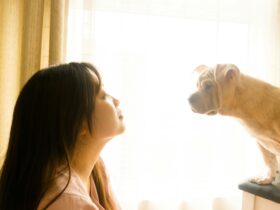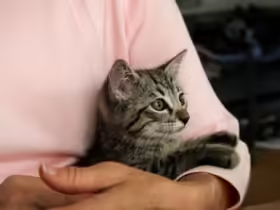Creating a safe and comfortable space for your dog at home is essential for their well-being and happiness. Just like us, dogs need a designated area where they can feel secure, relaxed, and at ease. This guide will walk you through the key elements of designing a perfect space for your furry friend, ensuring they have a cozy, safe, and functional environment.
1. Choose the Right Location
1.1 Selecting the Best Spot
- Quiet Area: Choose a location that is relatively quiet and away from the hustle and bustle of daily household activities. Dogs need a peaceful retreat where they can relax without being constantly disturbed.
- Temperature Control: Ensure the area is well-ventilated and has a stable temperature. Avoid placing the space near drafty windows, heaters, or air conditioning units that could make the environment uncomfortable.
1.2 Accessibility
- Easy Access: The space should be easily accessible to your dog at all times. Avoid placing their bed or crate in a location where they might feel trapped or isolated.
- Near Family: While it should be a quiet spot, it’s also beneficial if it’s near family activity areas so your dog can feel included without being overwhelmed.
2. Provide Comfortable Bedding
2.1 Choosing the Right Bed
- Size and Shape: Select a bed that is appropriately sized for your dog. It should provide enough room for them to stretch out comfortably. Consider orthopedic beds for older dogs or those with joint issues.
- Material: Opt for high-quality, washable materials that are soft and supportive. Memory foam beds or cushioned mats can provide added comfort.
2.2 Bedding Maintenance
- Cleaning: Regularly clean your dog’s bedding to keep it free from dirt, hair, and allergens. Washable covers or removable liners can make this task easier.
- Freshness: Ensure the bedding is always dry and fresh. Avoid placing it in damp or humid areas to prevent mold and unpleasant odors.
3. Ensure Safety
3.1 Hazard-Free Environment
- Remove Hazards: Keep the area free from small objects, electrical cords, and toxic plants that could pose a risk to your dog. Check for any sharp edges or small spaces where your dog might get stuck.
- Secure Furniture: Ensure that furniture and other items are stable and won’t tip over if your dog bumps into them. Avoid placing heavy objects in the area that could potentially fall.
3.2 Safety Features
- Gate or Barrier: If you need to restrict access to certain areas, use a pet gate or barrier to safely manage where your dog can go.
- Safe Toys: Provide safe, durable toys that are appropriate for your dog’s size and chewing habits. Avoid toys with small parts that could be a choking hazard.
4. Create a Personal Space
4.1 Designated Area
- Bed or Crate: Designate a specific area for your dog’s bed or crate. This will help them understand that this is their personal space where they can retreat and feel secure.
- Comfort Items: Place your dog’s favorite toys, blankets, or an item with your scent in their space to make it more inviting and comforting.
4.2 Personal Touches
- Enrichment Items: Include items that stimulate your dog’s senses, such as puzzle toys or interactive feeders. This helps keep them mentally engaged and entertained.
- Grooming Supplies: Keep grooming supplies like brushes and nail clippers in or near their space to maintain a sense of routine and familiarity.
5. Ensure Proper Nutrition and Hydration
5.1 Food and Water Station
- Accessible Bowls: Place food and water bowls in or near your dog’s space to ensure they have easy access to nourishment and hydration. Choose bowls that are the right size and easy to clean.
- Regular Refills: Ensure that water is always fresh and clean. Refill and clean water bowls daily to maintain proper hydration.
5.2 Feeding Schedule
- Routine Feeding: Establish a regular feeding schedule and stick to it. Consistency helps your dog feel secure and understand when to expect their meals.
- Dietary Needs: Tailor your dog’s diet to their specific needs, including age, size, and health condition. Consult your veterinarian for personalized dietary recommendations.
6. Incorporate Training and Exercise
6.1 Training Area
- Designated Training Space: Set up a specific area for training sessions where you can work with your dog on commands and behaviors. This area should be free from distractions and provide a positive learning environment.
- Training Tools: Keep training tools such as leashes, treats, and clickers readily available in or near the training space.
6.2 Exercise and Play
- Interactive Play: Include space for interactive play and exercise. Whether it’s a designated area for fetch or a space for agility training, ensure your dog has room to move and play safely.
- Exercise Routine: Incorporate regular exercise into your dog’s daily routine to keep them healthy and happy. Mix in different activities to keep them engaged and physically active.
7. Monitor and Adjust
7.1 Observing Your Dog’s Behavior
- Comfort and Safety: Pay attention to how your dog interacts with their space. If they seem uncomfortable or stressed, make adjustments as needed to improve their comfort and safety.
- Health Changes: Monitor your dog’s health and adjust their space as necessary to accommodate any changes in mobility or special needs.
7.2 Updating the Space
- Seasonal Adjustments: Adjust the space according to the seasons. For example, add extra bedding or a cooling mat in hot weather and a warm blanket or heater in colder months.
- Refresh and Revise: Periodically refresh the space by rotating toys, cleaning the area, and replacing worn-out bedding. This keeps the environment engaging and comfortable.
Conclusion
Creating a safe and comfortable space for your dog at home is essential for their overall well-being and happiness. By considering their needs for a quiet, comfortable, and secure environment, you can provide a haven where they feel relaxed and content. From choosing the right location and bedding to ensuring safety and incorporating enrichment, every detail contributes to a positive and fulfilling home life for your furry friend. With these tips, you’ll be well on your way to creating a perfect space that supports your dog’s health and happiness.











Leave a Reply